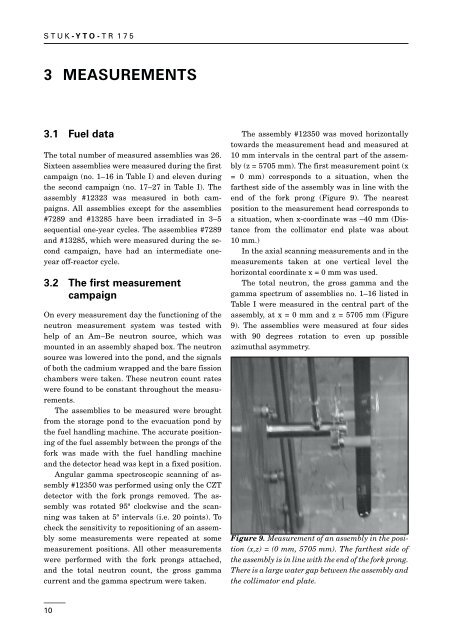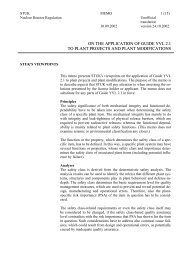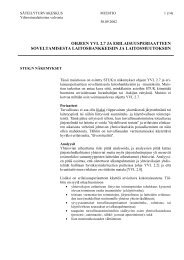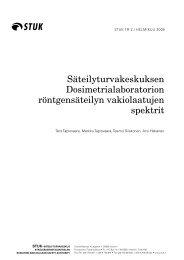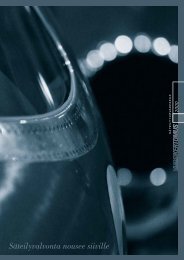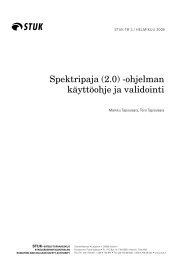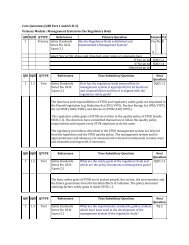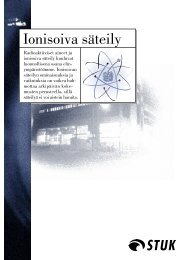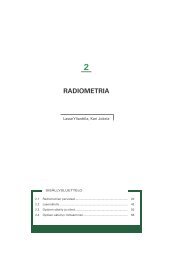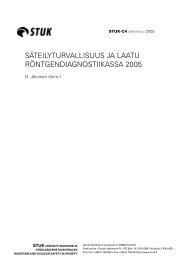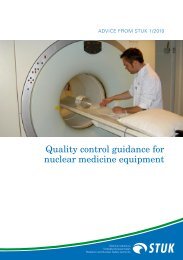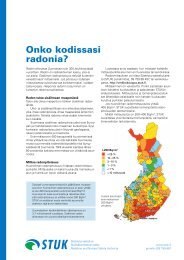Whole report - STUK
Whole report - STUK
Whole report - STUK
You also want an ePaper? Increase the reach of your titles
YUMPU automatically turns print PDFs into web optimized ePapers that Google loves.
<strong>STUK</strong>-YTO-TR 175<br />
3 MEASUREMENTS<br />
3.1 Fuel data<br />
The total number of measured assemblies was 26.<br />
Sixteen assemblies were measured during the first<br />
campaign (no. 1–16 in Table I) and eleven during<br />
the second campaign (no. 17–27 in Table I). The<br />
assembly #12323 was measured in both campaigns.<br />
All assemblies except for the assemblies<br />
#7289 and #13285 have been irradiated in 3–5<br />
sequential one-year cycles. The assemblies #7289<br />
and #13285, which were measured during the second<br />
campaign, have had an intermediate oneyear<br />
off-reactor cycle.<br />
3.2 The first measurement<br />
campaign<br />
On every measurement day the functioning of the<br />
neutron measurement system was tested with<br />
help of an Am–Be neutron source, which was<br />
mounted in an assembly shaped box. The neutron<br />
source was lowered into the pond, and the signals<br />
of both the cadmium wrapped and the bare fission<br />
chambers were taken. These neutron count rates<br />
were found to be constant throughout the measurements.<br />
The assemblies to be measured were brought<br />
from the storage pond to the evacuation pond by<br />
the fuel handling machine. The accurate positioning<br />
of the fuel assembly between the prongs of the<br />
fork was made with the fuel handling machine<br />
and the detector head was kept in a fixed position.<br />
Angular gamma spectroscopic scanning of assembly<br />
#12350 was performed using only the CZT<br />
detector with the fork prongs removed. The assembly<br />
was rotated 95º clockwise and the scanning<br />
was taken at 5º intervals (i.e. 20 points). To<br />
check the sensitivity to repositioning of an assembly<br />
some measurements were repeated at some<br />
measurement positions. All other measurements<br />
were performed with the fork prongs attached,<br />
and the total neutron count, the gross gamma<br />
current and the gamma spectrum were taken.<br />
The assembly #12350 was moved horizontally<br />
towards the measurement head and measured at<br />
10 mm intervals in the central part of the assembly<br />
(z = 5705 mm). The first measurement point (x<br />
= 0 mm) corresponds to a situation, when the<br />
farthest side of the assembly was in line with the<br />
end of the fork prong (Figure 9). The nearest<br />
position to the measurement head corresponds to<br />
a situation, when x-coordinate was –40 mm (Distance<br />
from the collimator end plate was about<br />
10 mm.)<br />
In the axial scanning measurements and in the<br />
measurements taken at one vertical level the<br />
horizontal coordinate x = 0 mm was used.<br />
The total neutron, the gross gamma and the<br />
gamma spectrum of assemblies no. 1–16 listed in<br />
Table I were measured in the central part of the<br />
assembly, at x = 0 mm and z = 5705 mm (Figure<br />
9). The assemblies were measured at four sides<br />
with 90 degrees rotation to even up possible<br />
azimuthal asymmetry.<br />
Figure 9. Measurement of an assembly in the position<br />
(x,z) = (0 mm, 5705 mm). The farthest side of<br />
the assembly is in line with the end of the fork prong.<br />
There is a large water gap between the assembly and<br />
the collimator end plate.<br />
10


